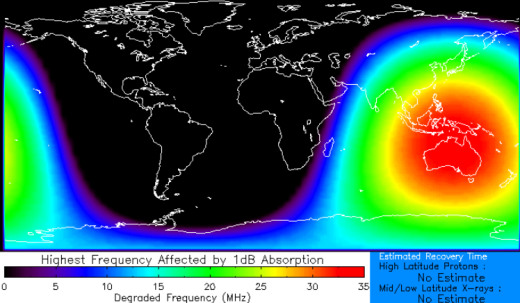Powerful solar flare unleashes colossal plasma plume, sparks radio blackouts across South Pacific (video)
The eruption caused shortwave radio blackouts across Australia and Southeast Asia.
A powerful solar flare erupted from a giant unstable sunspot last night, triggering radio blackouts on Earth and firing a hot plasma plume through the sun's atmosphere at speeds of 900,000 mph (400 km/s).
The long-duration solar flare from the sunspot region AR3575 began on Monday (Feb 5) at 8:30 p.m. EST (0130 GMT on Feb 6) and peaked at 10:15 EST (0315 GMT on Feb 6), according to solar physicist Keith Strong who posted details about the eruption on X.
The eruption also released a coronal mass ejection (CME) — a large release of plasma and magnetic field from the sun. If a CME hits Earth it can cause disturbances to our magnetic field leading to "geomagnetic storms" which can be troublesome for Earth-orbiting satellites but a delight to aurora chasers on the hunt for dramatic displays. Though it is unlikely that this particular CME will strike Earth due to the location of the eruption being very far south on the sun, the CME could just pass straight under us, according to Strong.
Related: Solar maximum is coming, but we won't know it happened until 7 months after it's over

The M-flare caused extensive radio blackouts due to the strong pulse of X-rays and extreme ultraviolet radiation sent barrelling toward Earth at the time of the eruption. Traveling at the speed of light, the radiation reached Earth in just over eight minutes and ionized the upper layer of Earth's atmosphere — the thermosphere — triggering shortwave radio blackouts on the sun-lit portion of Earth at the time. Australia and Southeast Asia experienced shortwave blackouts and Ham radio operators and mariners in the area may have noticed a loss of signal at frequencies below 30 MHz for as much as an hour after the flare's peak according to Spaceweather.com.
Solar flares are caused when magnetic energy builds up in the solar atmosphere and is released in an intense burst of electromagnetic radiation. They are categorized by size into lettered groups, with X-class being the most powerful. Then there are M-class flares that are 10 times smaller than X-class flares, then C-class, B-class and finally A-class flares which are too weak to significantly affect Earth. Within each class, numbers from 1 to 10 (and beyond, for X-class flares) denote a flare's relative strength. The recent flare clocked in at M4.2 according to the Space Weather Prediction Center of the National Oceanic and Atmospheric Administration (NOAA).

NASA captured the stunning images and video of the solar flare with its Solar Dynamics Observatory. This space-based telescope keeps a continuous eye on the sun in different wavelengths.
Get the Space.com Newsletter
Breaking space news, the latest updates on rocket launches, skywatching events and more!
Even more solar activity could be on the horizon as another unstable sunspot region 3576 comes into view. NOAA has suggested an elevated probability of M-class and possibly X-class flare activity over the next few days. As region 3576 rotates into view, region 3575 will begin to vanish beyond the western limb around Feb. 7-8.
Join our Space Forums to keep talking space on the latest missions, night sky and more! And if you have a news tip, correction or comment, let us know at: community@space.com.

Daisy Dobrijevic joined Space.com in February 2022 having previously worked for our sister publication All About Space magazine as a staff writer. Before joining us, Daisy completed an editorial internship with the BBC Sky at Night Magazine and worked at the National Space Centre in Leicester, U.K., where she enjoyed communicating space science to the public. In 2021, Daisy completed a PhD in plant physiology and also holds a Master's in Environmental Science, she is currently based in Nottingham, U.K. Daisy is passionate about all things space, with a penchant for solar activity and space weather. She has a strong interest in astrotourism and loves nothing more than a good northern lights chase!









